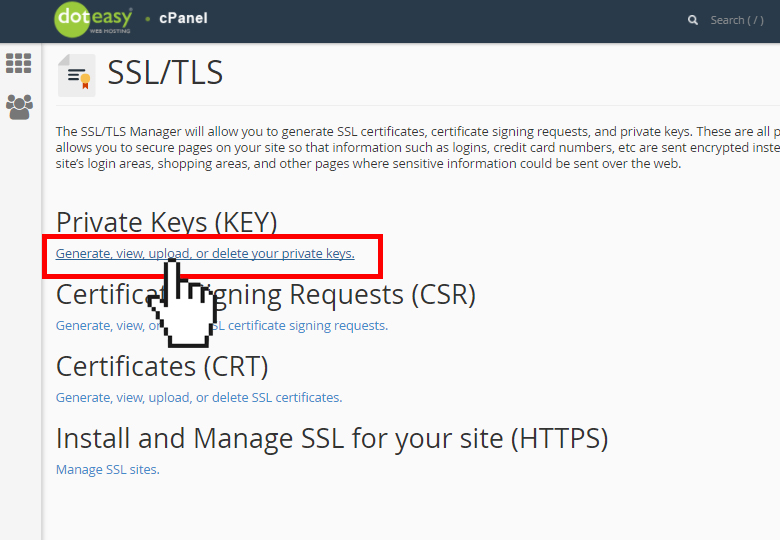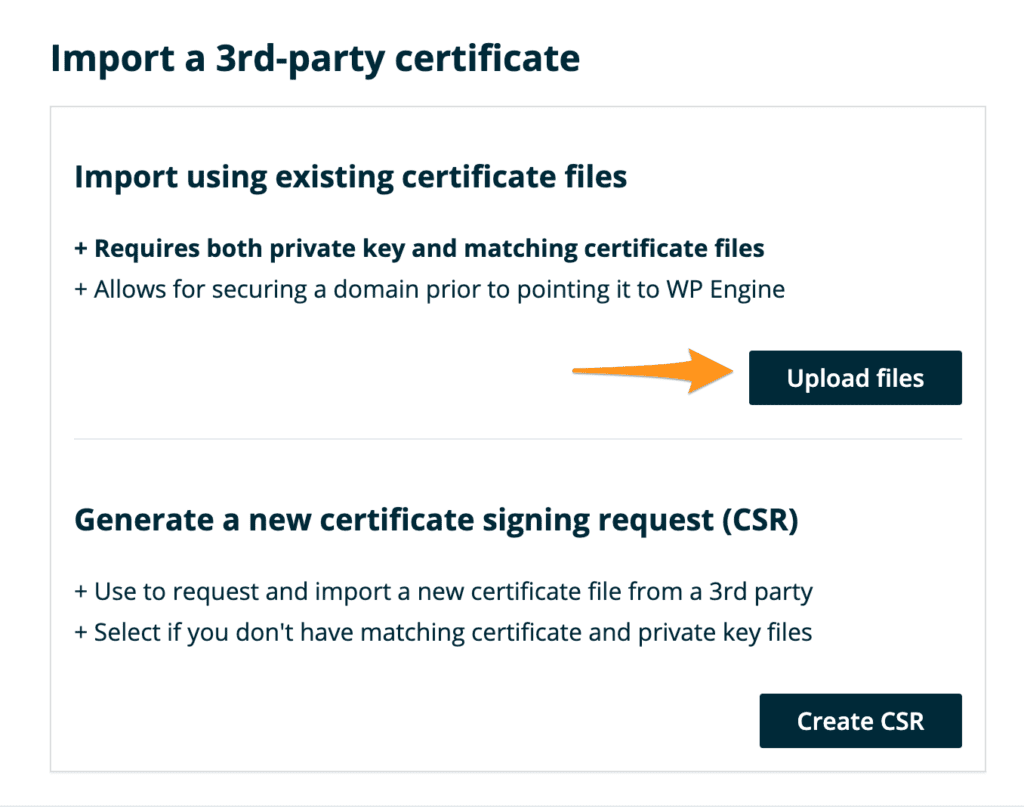How to Generate a Public/Private KeyPair for Use With Solaris Secure Shell
- Generate Ssl Private Key Ubuntu
- Generate A Private Ssl Keyboard
- Ssl Private Key File
- Generate A Private Ssl Key In Computer
Users must generate a public/private key pair when their site implementshost-based authentication or user public-key authentication. For additionaloptions, see the ssh-keygen(1) manpage.
Before You Begin
SSL.com’s public CSR and Key Generator is currently down for maintenance as part of our website’s redesign and update. We will be back soon with a new and updated version. In the mean time, we encourage our customers to learn about generating CSRs and keys in. Apr 07, 2015 These keys are created together as a pair and work together during the SSL/TLS handshake process (using asymmetric encryption) to set up a secure session. The private key is a text file used initially to generate a Certificate Signing Request (CSR), and later to secure and verify connections using the certificate created per that request. The private key is used to create a digital.
Determine from your system administrator if host-based authenticationis configured.
Start the key generation program.
where -t is the type of algorithm, one of rsa, dsa, or rsa1.
Specify the path to the file that will hold the key.
Bydefault, the file name id_rsa, which represents an RSAv2 key, appears in parentheses. You can select this file by pressing the Return key. Or, you can type an alternative file name.
The file name of the public key is created automatically by appendingthe string .pub to the name of the private key file.
Type a passphrase for using your key.
This passphraseis used for encrypting your private key. A null entry is stronglydiscouraged. Note that the passphrase is not displayed when youtype it in.
Retype the passphrase to confirm it.
Check the results.
Check that the path to the keyfile is correct.
At this point, you have created a public/private key pair.
Choose the appropriate option:
If your administrator has configuredhost-based authentication, you might need to copy the local host's publickey to the remote host.
You can now log in to the remote host.For details, see How to Log In to a Remote Host With Solaris Secure Shell.
Type the command on one line with no backslash.
When you are prompted, supply your login password.
If your site uses user authentication with public keys, populateyour authorized_keys file on the remote host.
Copy your public key to the remote host.
Type thecommand on one line with no backslash.
When you are prompted, supply your login password.
Whenthe file is copied, the message “Key copied” is displayed.
(Optional) Reduce the prompting for passphrases.
For a procedure, see How to Reduce Password Prompts in Solaris Secure Shell. For more information, see the ssh-agent(1) and ssh-add(1) man pages.
Example 19–2 Establishing a v1 RSA Key for a User
In the following example, the user cancontact hosts that run v1 of the Solaris Secure Shell protocol. To be authenticated by v1hosts, the user creates a v1 key, then copies the public key portion to theremote host.
While Encrypting a File with a Password from the Command Line using OpenSSLis very useful in its own right, the real power of the OpenSSL library is itsability to support the use of public key cryptograph for encrypting orvalidating data in an unattended manner (where the password is not required toencrypt) is done with public keys.
The Commands to Run
Generate a 2048 bit RSA Key
Generate Ssl Private Key Ubuntu
You can generate a public and private RSA key pair like this:
openssl genrsa -des3 -out private.pem 2048
That generates a 2048-bit RSA key pair, encrypts them with a password you provideand writes them to a file. You need to next extract the public key file. You willuse this, for instance, on your web server to encrypt content so that it canonly be read with the private key.
Export the RSA Public Key to a File
This is a command that is
openssl rsa -in private.pem -outform PEM -pubout -out public.pem
The -pubout flag is really important. Be sure to include it.
Next open the public.pem and ensure that it starts with-----BEGIN PUBLIC KEY-----. This is how you know that this file is thepublic key of the pair and not a private key.

To check the file from the command line you can use the less command, like this:
less public.pem
Do Not Run This, it Exports the Private Key
A previous version of the post gave this example in error.
Generate A Private Ssl Keyboard
openssl rsa -in private.pem -out private_unencrypted.pem -outform PEM
Ssl Private Key File
The error is that the -pubout was dropped from the end of the command.That changes the meaning of the command from that of exporting the public keyto exporting the private key outside of its encrypted wrapper. Inspecting theoutput file, in this case private_unencrypted.pem clearly shows that the keyis a RSA private key as it starts with -----BEGIN RSA PRIVATE KEY-----.
Visually Inspect Your Key Files

It is important to visually inspect you private and public key files to makesure that they are what you expect. OpenSSL will clearly explain the nature ofthe key block with a -----BEGIN RSA PRIVATE KEY----- or -----BEGIN PUBLIC KEY-----.
You can use less to inspect each of your two files in turn:
less private.pemto verify that it starts with a-----BEGIN RSA PRIVATE KEY-----less public.pemto verify that it starts with a-----BEGIN PUBLIC KEY-----
The next section shows a full example of what each key file should look like.
The Generated Key Files
The generated files are base64-encoded encryption keys in plain text format.If you select a password for your private key, its file will be encrypted withyour password. Be sure to remember this password or the key pair becomes useless.
The private.pem file looks something like this:
Generate A Private Ssl Key In Computer
The public key, public.pem, file looks like:
Protecting Your Keys
Depending on the nature of the information you will protect, it’s important tokeep the private key backed up and secret. The public key can be distributedanywhere or embedded in your web application scripts, such as in your PHP,Ruby, or other scripts. Again, backup your keys!
Remember, if the key goes away the data encrypted to it is gone. Keeping aprinted copy of the key material in a sealed envelope in a bank safety depositbox is a good way to protect important keys against loss due to fire or harddrive failure.
Oh, and one last thing.
If you, dear reader, were planning any funny business with the private key that I have just published here. Know that they were made especially for this series of blog posts. I do not use them for anything else.
Found an issue?
Rietta plans, develops, and maintains applications.
Learn more about our services or drop us your email and we'll e-mail you back.